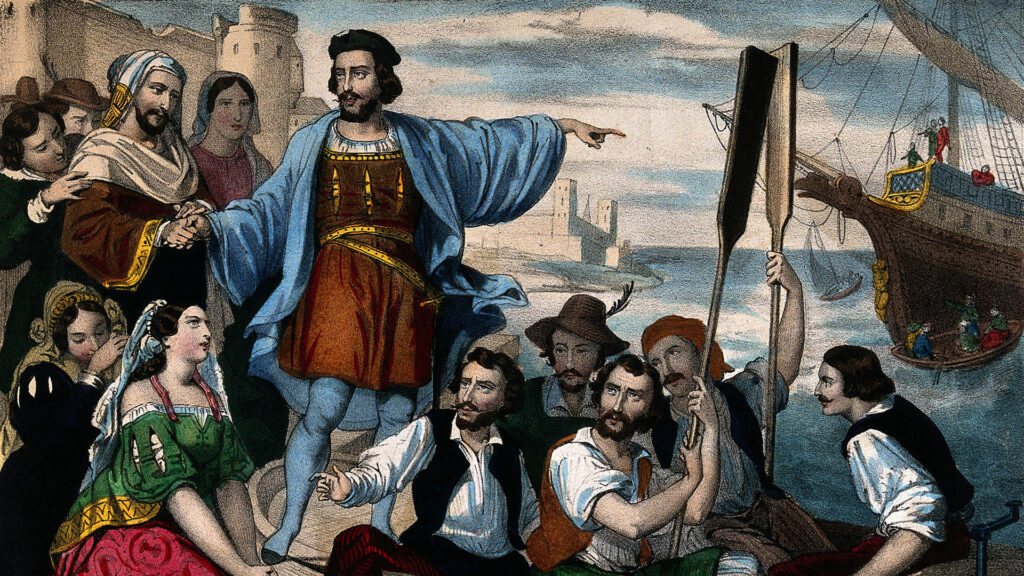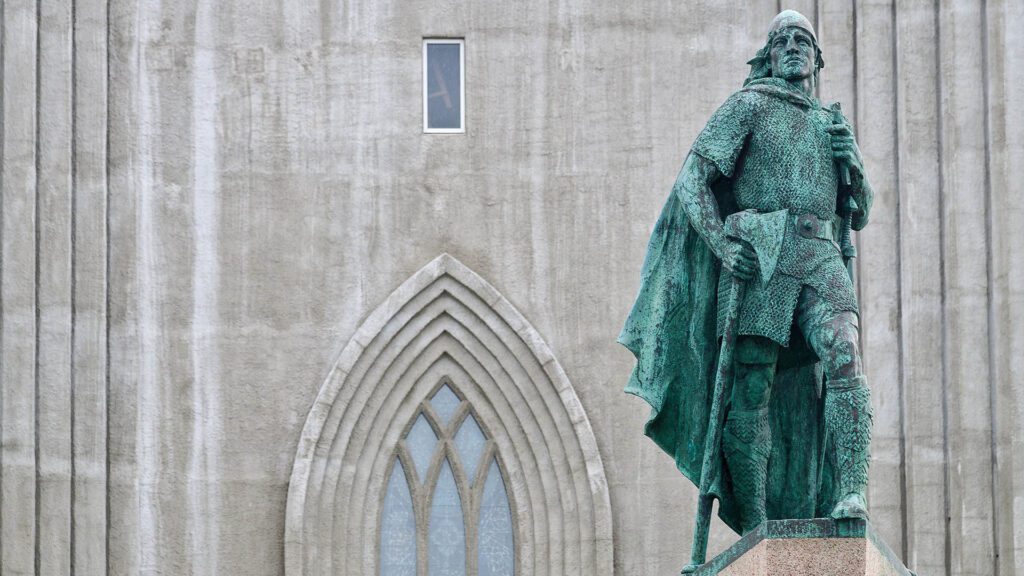Can you mention some famous Icelanders? Björk obviously. Chess master Bobby Fischer was an Icelander for the last years of his life. Damon Albarn, the singer of Blur, has dual British/Icelandic citizenship. Then there’s James Bond and Snow White. Bram Stoker also possibly had a good Icelandic friend… Ok, we’re stretching the truth a bit here. Or maybe not.
Since Icelanders are so few, we probably know more about our personal history than many other nations. We have Íslendingabók – The Book of Icelanders online (not to be confused about the actual book, written in the Middle Ages). It’s a genealogy site where most Icelanders can trace their family back to the Settlement era. Some can even go further back.
Icelanders have historically taken meticulous care of registering births and deaths in the country. Even if there are a few blanks in our history today. In 1703 a census was made of every person living in Iceland, and it is the oldest complete census of any country that has survived.
Are you “Íslandsvinur”?
So, we know who’s who. But because there are so few of us, we have a bit of a minority complex. We have a dire need to be seen as important in the world. We love it when anything at all that has to do with Icelandic culture is mentioned anywhere in the world. As a fun side note, much to the chagrin of many, every single famous person who steps one foot onto Iceland is a “Friend of Iceland” (Íslandsvinur).
We keep a close eye on who writes about Iceland. And then become incredibly offended if it is not to our liking.
In 1593, a book by Arngrímur the learned, an Icelandic scholar and Christian apologist, was published. In it he criticized the works of numerous authors who had written about the people of Iceland. His main target was a poem by Gories Peerse, a merchant who had written an entertaining and somewhat slanderous poem about Icelandic geography and ethnography.
As we have said before, Icelanders can be a bit pedantic, and we want things to be correct.
Disney’s Snow White was based on an Icelandic Woman
Snow White, the protagonist Disney’s first feature-length animated movie, was based on an Icelandic woman, Kristín Sölvadóttir. She was from Siglufjörður and was born in 1912.

How can that be, you might ask? Well, a West Icelander* Karl Stefánsson, who had taken up the name Charles Thorson, born in Winnipeg, was the creator. Charlie was a political cartoonist, character designer, children’s book author, and illustrator. He is credited, for example, for having designed an early version of the then-yet-unnamed Bugs Bunny.
Kristín went to Winnipeg when she was 18 to live with an aunt, mostly to learn English. She was working in a café there when Charlie started coming for a visit. They became friends quickly. Despite their age difference (he was over 40, and she was just 20), he asked her to marry him. She did say yes, and he gave her a picture where he was the prince, and she was a princess. However, she changed her mind.
Around that time, Charlie got a job working for Disney. And one of his sketches for Snow White, which he based on Kristín, was used.
So is Disney’s Snow White one of the most famous Icelanders? Hardly as Kristín was undoubtedly not the only likeness used for the animation, but this is a fun story.
James Bond was based on an Icelandic Man
Icelanders sometimes jest that James Bond is based on an Icelandic farmer, Jón bóndi, but that’s just for fun.

However,… it might actually be true that he’s based on a (West) Icelandic. Ian Fleming himself said that he was influenced by a man called William Samuel Stephenson. He was a Canadian soldier and fighter pilot. Businessman and spymaster. He was a senior representative of the British Security Coordination for the western allies during World War II. He is best known for his wartime intelligence codename Intrepid. Fleming said that James Bond was a highly romanticized version of Stephenson.
But if he was a Canadian soldier, how can we claim he was Icelandic? Well, you see, his mother was Icelandic, and his father was Scottish. When he was young, he was adopted by other Icelanders when his father died, and his mother couldn’t care for him on her own. The Icelandic couple who took him in were farmers from the Snæfellsnes peninsula.
Among his other accomplishments was inventing a way to send photos via radiogram.
And how did Ian Fleming know about William? They were neighbors in Jamaica. So, Jón bóndi wasn’t so far off after all, which would mean he’s one of the most famous Icelanders in the world. Ok, we’ll admit that that is a bit of a stretch.
The Powers of Darkness – The Lost Early Version of Dracula

This is a fun one. In 1901 a book called Makt myrkranna (The Powers of Darkness) was published in Iceland. A year earlier, it had been serialized in a newspaper called Fjallkonan (The Lady of the Mountains). The book was published under Bram Stoker’s and the translator’s name (Valdimar Ásmundsson). The book became very popular in the first half of the 20th century, so popular that Makt myrkranna became the preferred way of referring to Dracula in film and literature. Iceland’s only Nobel prize winner (in literature), Halldór Laxness, called it one of the best Icelandic novels imported from abroad.
Then in 1986, the book became famous internationally when American scholar Richard Dalby published an English translation of the preface, which was supposed to have been written by Bram Stoker at the time.
People were very excited about this; how could it be that an early version of Dracula could have been published in Iceland and nowhere else? Turns out, it wasn’t so. This came to light in 2017 when an English version of the book was published. Turns out the Icelandic serialized story had initially been published in Sweden as a serial story, where it was even called the same name.
At most, Makt myrkranna and the Swedish version Mörkets makter, are unauthorized fan fiction, according to Bram Stoker’s biographer David John Skal. But for a while, people actually believed that Bram Stoker was a friend of an Icelander and gave him an early draft of Dracula.
Did Icelanders Tell Columbus About Countries in the West?
Columbus wrote a letter to the King and Queen of Spain, Ferdinand, and Isabella, in January 1495. In the letter, he justified and defended his actions as a governor of the Spanish colonies on the West Coast. He used the letter also to praise his achievements and abilities, but his opponents in Madrid had at that time criticized him harshly and slandered him.

Also, in the letter, he said that in February 1477, he sailed 600 km beyond the island of Tile (also named Thule in sources), whose southern coast is 73 degrees from the equator. He also said that the flood level of the island was about 41 km.
This letter is used as proof by those who believe Columbus came to Iceland. And that Icelanders told him about unexplored lands in the west. Finnur Magnússon, the Danish king’s secret archivist, was the first to draw attention to this in an 1833 article. Since then, many other scholars have written about this.
He probably didn’t come to Iceland
In 2013, historian Sigurður Hjartarson (also the founder of the Icelandic phallological museum) wrote an article in an Icelandic history journal called Saga. He pointed out that most of what is mentioned in the letter from 1495 regarding Columbus’ journey to the Arctic does not stand up to scrutiny.
Firstly, Columbus placed Tile much further north than Iceland. Secondly, even if a ship can come to Iceland in February, it is unlikely. He also points out that Columbus’ claim that the flood level in Iceland is about 41 m is absurd. All attempts by scholars to evade that fact with theoretical acrobatics are unbelievable.
Finally, Sigurður said that those who assumed Columbus’ voyage to Iceland were using an old and very faulty translation of the letter. Sigurður believes that Columbus may have received the information in the letter from English sailors who sailed to Portugal or from the Portuguese who sailed to England. He further points out that there are almost no reliable records of Columbus’s life before 1485, not even his date of birth.
So, it must be said that the scholars who criticize this story are probably correct. Columbus probably never came to Iceland and didn’t receive information about land in the west from Icelanders. But it cannot be wholly rejected.
After all, Columbus was not the first European to discover North America.
Leif “The Lucky” Eiríksson

This will be the last entry of this blog post, and this one is definitely one of the most famous Icelanders of all. You might wonder why we have Leif the Lucky here, the first European man who discovered Vínland (as far as we know, at least). He was obviously not the first to discover that land because thousands of people already lived there.
Leif was the son of Eiríkur the Red. Eiríkur is credited with being the first (European) man to settle in Greenland. Again, obviously, there were people before Europeans, so the age-old claim that he was the first settler there is, of course, wrong.
Eiríkur the Red – The Father
Eiríkur was born in Norway and was the son of Þorvaldur Ásvaldsson. The two fled Norway to Iceland because Þorvaldur killed a man. They fled to Iceland. Some years later, Eiríkur had to flee Iceland because he also killed people. He then spent the next three years exploring the coast of Greenland. When he returned to Iceland, he told people of this new land, and 25 boats went on their way to Greenland, with 14 arriving at the shore. The other 11 perished along the way or turned back.
Leif the Lucky (born ca 970) was born and bred in Iceland, so one might wonder how he was anything but. Well, other Scandinavian nations claim he was Norwegian from Iceland. We disagree with that; Iceland was a fully-fledged country by the time Leif was born, and we even had established the world-famous parliament in Þingvellir. So, the Icelander Leif the Lucky was the first European man to visit North America. This probably makes Leif the most famous Icelander, maybe after Björk.
*West-Icelandic people are people and their descendants who emigrated to Brazil, US, and Canada in the late 19th and early 20th centuries. Most people moved to Gimli by Lake Winnipeg in Manitoba, Canada.
Check out our Walk with a Viking tour to learn more about Iceland.
Please signup HERE for our newsletter for more fun facts and information about Iceland!









